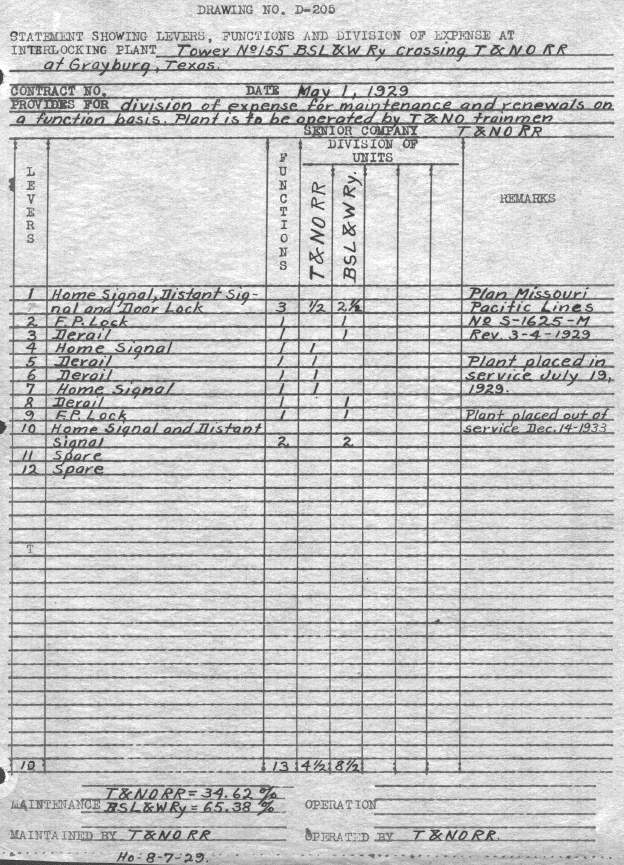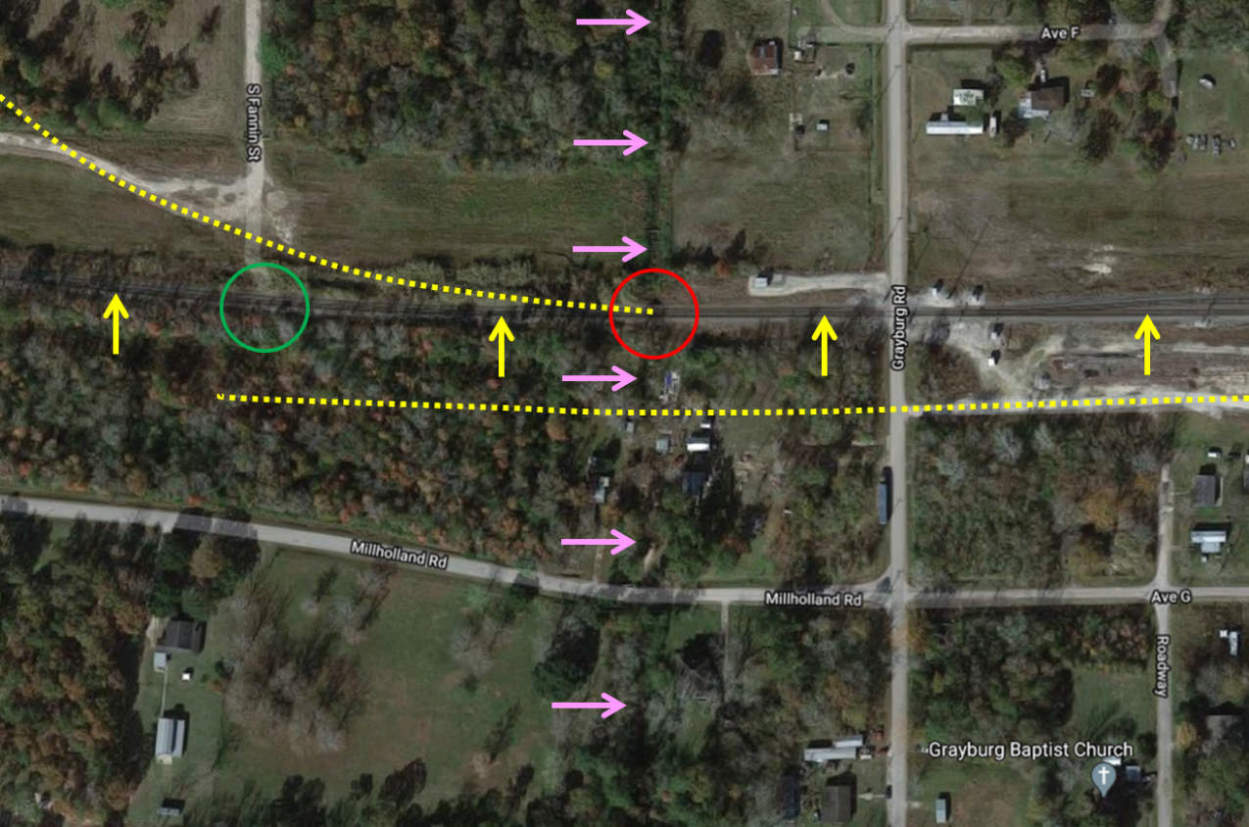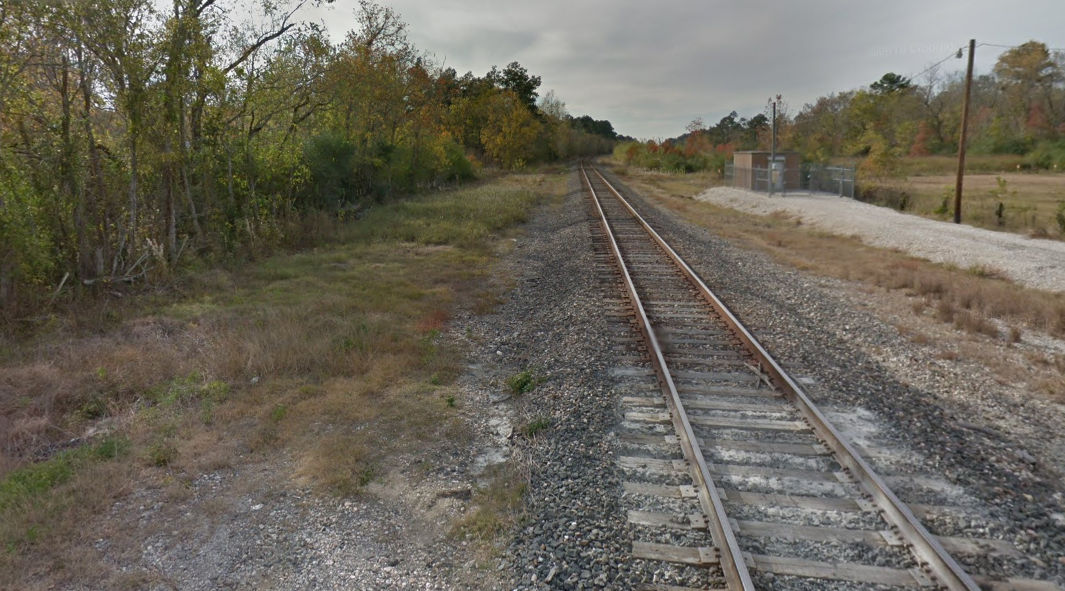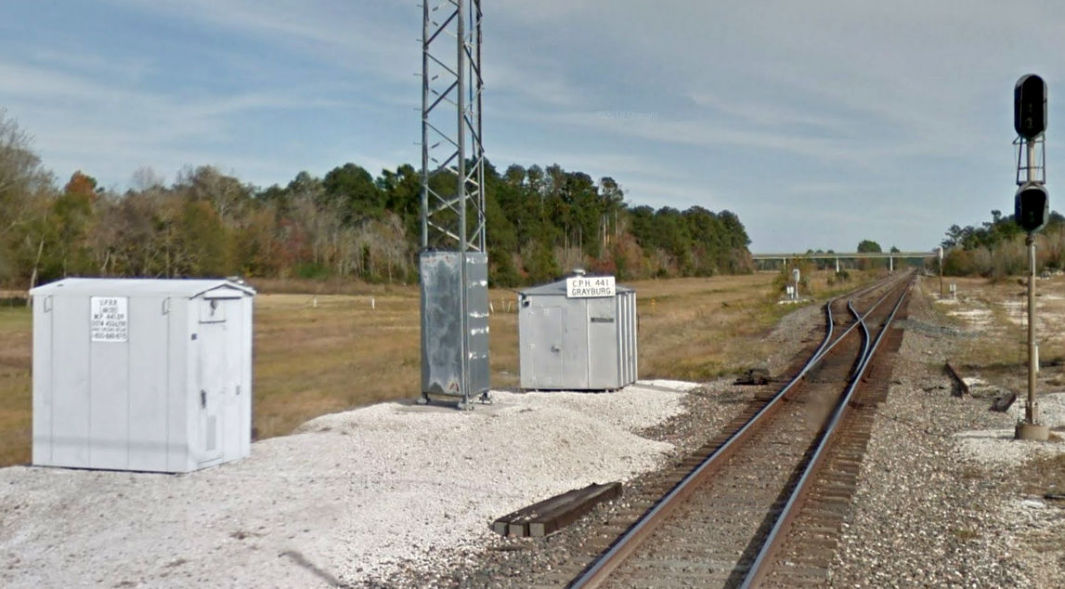Texas Railroad History - Tower 155 - Grayburg
A Crossing of the Beaumont, Sour Lake & Western Railway and
the Texas & New Orleans Railway
Sour Lake is the oldest settlement in Hardin County, a small community noted
originally for mineral springs that gave the town its name. Drilling had
produced modest amounts of oil as early as 1893, but in 1902, a huge "gusher"
hit; Sour Lake became a boom town overnight. By the end of 1903, the Texas & New
Orleans (T&NO) Railroad, the primary operating subsidiary of Southern
Pacific (SP) in Texas and Louisiana, had built a spur into town from Nome, on their
Houston/Beaumont main line, seven miles south of Sour Lake. The following year, the
newly chartered Beaumont, Sour Lake & Western (BSL&W) Railway built twenty miles
from Beaumont to Sour Lake. The rail line terminated a mile south of Sour Lake; the boom had packed the town with upwards of 10,000 people and
businesses to support them, so there was no room for a second railroad into
town.
The BSL&W would have been content to continue functioning as a
short-line railroad built to bring oil out of the Sour Lake field to Beaumont
for processing and shipping, but B. F. Yoakum, Chairman of the St. Louis - San
Francisco Railway, had other ideas. Yoakum needed a rail line between Houston
and Beaumont for his Gulf Coast Lines (GCL) consortium which was assembling a
large rail network from New Orleans to Brownsville centered on Houston. The BSL&W's
tracks already covered a quarter of the distance from Beaumont to Houston, so
Yoakum bought the BSL&W in 1905 and assigned it to the GCL. In 1908, the BSL&W
reported to the Railroad Commission of Texas (RCT) that it had completed
building 62 miles of track from Grayburg to Houston. Grayburg was the name of
the community that had settled at the original terminus of the BSL&W tracks near
Sour Lake. The community sprang up around the Thompson-Ford Lumber Co. which
built a sawmill there in 1908. The extension to Houston required the BSL&W to cross T&NO's Nome
- Sour Lake
spur at Grayburg, but the crossing was not interlocked.
On January 1, 1925, Missouri Pacific
(MP) acquired the BSL&W
when they purchased the entire GCL portfolio of railroads. Four years later, MP
embarked on a frenzy of interlocker construction for its GCL lines. Over a
9-month period commencing January 3, 1929, RCT approved eleven cabin
interlockers in which MP had an interest. The eighth one in the sequence was
Tower 155 at Grayburg, approved by RCT on July 19, 1929 as a 12-function
mechanical plant housed in a trackside cabin. The interlocker primarily
benefitted MP trains which no longer had to stop at the T&NO crossing unless it
was occupied. Prior to Tower 155, all MP and T&NO trains were required to stop
before proceeding across the diamond at Grayburg.
 |
Left:
(collection of Carl Codney) The D-205 drawing was a form used by SP to
document the functions and expense sharing arrangement for interlockers
in which it had a financial interest. This one, for Tower 155 at
Grayburg, is dated May 1, 1929, roughly six weeks before the
installation was approved by RCT. This is a substantially shorter
planning period than normal (more typically several months.) The
document notes that the design plan was released by MP on March 4, 1929.
It also notes that the plant was "...placed out of service Dec. 14,
1933".
RCT's published documentation states that Tower 155
originally had 12 functions but this form shows 13, implying that it is
a rewritten modified version of the original document (since nothing is
crossed out, as is often seen on revised originals.) Undoubtedly the
additional function was for the door lock which was split evenly, 1/2
function to each railroad. For unknown reasons, they appended the door
lock to Lever 1 giving it three functions: home and distant signal for
the BSL&W plus the door lock. How this worked in practice is
undetermined. Lever 10 was also a home and distant signal for the BSL&W,
in the opposite direction, but which
direction is unknown.
Cabin interlockers were used where a busy
line (here, the MP) crossed a lightly used line (the T&NO.) The controls
were operated by train crewmembers of the lightly used line when they
needed to cross the busy line. At all other times, the signals allowed
unrestricted movements on the busier line. The obvious advantage of a
cabin interlocker is that it eliminated the recurring expense for tower
staffing. The cabin was also a much simpler structure compared to a
manned tower, so maintenance expenses were also reduced.
Note
that there were no distant signals for the T&NO. Since T&NO train crews
were always required to stop before crossing the diamond (to operate the
cabin controls), there was no need for an advance warning for T&NO
trains; they were stopping anyway.. |
By the early 1930s, pipelines had
eliminated tank car traffic from Sour Lake and the population had declined
significantly. Service to Sour Lake could no longer be justified and T&NO abandoned the spur from Nome in 1933.
With the crossing removed, Tower 155 was retired on December 14, 1933 after only
four and half years of service. Today,
MP successor Union Pacific continues to operate the former BSL&W route as a major
line between Houston and Beaumont.

Much has changed in the vicinity of the Tower 155 crossing between 1952 (above,
(c)historicaerials.com) and 2019 (below).
Even in 1952, the T&NO (pink) had already been abandoned for 20 years. One thing
that hasn't changed much is the MP east/west main line (yellow solid line) now
owned by UP (yellow arrows.) A dark shadow near the former T&NO crossing (red
circle) suggests that the cabin for the former interlocker might have still been
standing in 1952. A spur to the north departed the main line near the crossing
and curved north. The 1952 image shows a very clear grade extending north into
Sour Lake but whether tracks were on it at the time cannot be determined. There
are few traces of this spur today. A support track (yellow dashes) south of the
main line is also apparent on the 1952 image and appears to have had rails.
Parts of that right-of-way (ROW) still exist as gravel roads, but it no longer
extends west of the T&NO ROW. S. Fannin St. formerly crossed over the main line
(green circle) and proceeded southeast to an intersection with Millholland Rd.
near its grade crossing with the T&NO ROW.


Above: west view at Grayburg
Rd. Below: east
view at Grayburg Rd. (Google Street View)


Last Revised: 4/16/2021 JGK - Contact the Texas
Interlocking Towers Page.




